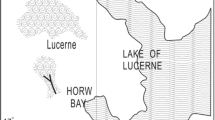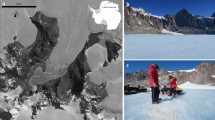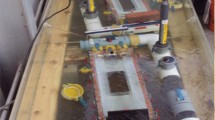Abstract
Phospholipid analyses were performed on water column particulate and sediment samples from Ace Lake, a meromictic lake in the Vestfold Hills, Antarctica, to estimate the viable microbial biomass and community structure in the lake. In the water column, methanogenic bacterial phospholipids were present below 17 m in depth at concentrations which converted to a biomass of between 1 and 7×108 cells/liter. Methanogenic biomass in the sediment ranged from 17.7×109 cells/g dry weight of sediment at the surface to 0.1×109 cells/g dry weight at 2 m in depth. This relatively high methanogenic biomass implies that current microbial degradation of organic carbon in Ace Lake sediments may occur at extremely slow rates. Total microbial biomass increased from 4.4×108 cells/ liter at 2 m in depth to 19.4×108 cells/liter at 23 m, near the bottom of the water column. Total nonarchaebacterial biomass decreased from 4.2 ×109 cells/g dry weight in the surface sediment (1/4 the biomass of methanogens) to 0.06×108 cells/g dry weight at 2 m in depth in the sediment. Phospholipid fatty acid profiles showed that microeukaryotes were the major microbial group present in the oxylimnion of the lake, while bacteria dominated the lower, anoxic zone. Sulfate-reducing bacteria (SRB) comprised 25% of the microbial population at 23 m in depth in the water column particulates and were present in the surface sediment but to a lesser extent. Biomass estimates and community structure of the Ace Lake eco-system are discussed in relation to previously measured metabolic rates for this and other antarctic and temperate ecosystems. This is the first instance, to our knowledge, in which the viable biomass of methanogenic and SRB have been estimated for an antarctic microbial community.
Similar content being viewed by others
References
Balkwill DL, Leach FR, Wilson JT, McNabb JF, White DC (1988) Equivalence of microbial biomass measures based on membrane lipid and cell wall components, adenosine triphosphate, and direct counts in subsurface aquifer sediments. Microb Ecol 16:73–84
Bayly IAE, Burton HR (1987) Distribution ofParalapidocera antarctica in Ace Lake. Aust J Mar Freshw Res 38:537–543.
Boone DR, Whitman WB (1988) Proposal of minimum standards for describing new taxa of methanogenic bacteria. Int J Sys Bacteriol 38:212–219.
Bryant MP, Wolin EA, Wolin MJ, Wolfe RS (1967)Methanobacillus omelianskii, a symbiotiic association of two species of bacteria. Arch Microbiol 59:20–31
Burch MD (1988) Annual cycle of phytoplankton in Ace Lake, an ice covered, saline meromictic lake. In: Ferris JM, Burton HR, Johnstone GW, Bayly IAE (eds) Biology of the Vestfold Hills, Antarctica. Kluwer Academic Publishers, Dordrecht, pp 59–75
Burton HR (1980) Methane in a saline Antarctic lake. In: Trudinger PA, Walter MR (eds) Biogeochemistry of ancient and modern environments. Australian Academy of Science, Canberra, pp 243–251
Burton HR (1981) Chemistry, physics and evolution of antarctic saline lakes. Hydrobiologia 82:339–362
Burton HR, Barker RJ (1979) Sulfur chemistry and microbiological fractionation of sulfur isotopes in a saline Antarctic lake. Geomicrobiology J 1:329–340
Clarke A (1979) On living in cold water: k-strategies in Antarctic benthos. Mar Biol 55:111–119
Culbertson CW, Zehnder AJB, Oremland RS (1981) Anaerobic oxidation of acetylene by estuarine sediments and enrichment cultures. Appl Environ Microbiol 41:396–403
Edlund A, Nichols PD, Roffey R, White DC (1985) Extractable and lipopolysaccharide fatty acid and hydroxy acid profiles fromDesulfovibrio species. J Lipid Res 26:982–988
Ellis-Evans JC (1984) Methane in maritime antarctic freshwater lakes. Polar Biol 3:63–71
Ellman GL (1959) Tissue sulphyldryl groups. Arch Biochem Biophys 82:70–74
Erwin JA (1973) Comparative biochemistry of fatty acids in eucaryotic microorganisms. In: Erwin JA (ed) Lipids and biomembranes of eucaryotic microorganisms. Academic Press, New York, pp 41–143
Eyssen H, Verhulst A (1984) Biotransformation of linoleic acid and bile acids byEubacterium lentum. Appl Environ Microbiol 47:39–43
Dowling NJE, Widdel F, White DC (1986) Phospholipid ester-linked fatty acid biomarkers of acetate-oxidizing sulfate-reducers and other sulfide-forming bacteria. J Gen Microbiol 132:1815–1825
Franzmann PD, Skyring GW, Burton HR, Deprez PP (1987) Sulfate reduction rates and some aspects of the limnology of four lakes and a fjord in the Vestfold Hills, Antarctica. In: Ferris JM, Burton HR, Johnstone GW, Bayly IAE (eds) Biology of the Vestfold Hills, Antarctica. Kluwer Academic Publishers, Dordrecht, pp 25–33
Gillan FT, Hogg RW (1984) A method for the estimation of bacterial biomass and community structure in mangrove-associated sediments. J Microbial Methods 2:275–293
Goodfellow M, Minnikin DE (1985) Introduction to chemosystematics. In: Goodfellow M, Minnikin DE (eds) Chemical methods in bacterial systematics. Soc Appl Bact Tech Ser No 20, Academic Press, London, pp 1–15
Green DR, Stull JR, Heesen TC (1986) Determination of chlorinated hydrocarbons in coastal waters using a mooredin situ sampler and transplanted live mussels. Mar Pollut Bull 17:324–329
Guckert JB, Antworth CP, Nichols PD, White DC (1985) Phospholipid, ester-linked fatty acid profiles as reproducible assays for changes in procaryotic community structure of estuarine sediments. FEMS Microbiol Ecol 31:147–158
Guckert JB, Hood MA, White DC (1986) Phospholipid ester-linked fatty acid profile changes during nutrient deprivation ofVibrio cholerae: Increase in thetrans/cis ratio and proportions of cyclopropyl fatty acids. Appl Environ Microbiol 52:794–801
Guckert JB, Ringelberg DB, White DC (1987) Biosynthesis oftrans fatty acids from acetate in the bacteriumPseudomonas atlantica. Can J Microbiol 33:748–754
Hand RM (1980) Bacterial populations of two saline antarctic lakes. In: Trudinger PA, Walter MR (eds) Biogeochemistry of ancient and modern environments. Australian Academy Science Press, Canberra, pp 123–129
Hand RM, Burton HR (1981) Microbial ecology of an Antarctic saline meromictic lake. Hydrobiologia 82:363–374
Hanselmann KW (1986) Microbially mediated processes in environmental chemistry. Chimia 40:146–159
Langworthy TA (1985) Lipids of archaebacteria. In: Woese CR, Wolfe RS (eds) Archaebacteria. Academic Press, New York, pp 459–497
Langworthy TA, Tornabene TG, Holzer G (1982) Lipids of archaebacteria. Zbl Bakt Hyg I Abt Orig C 3:228–244
Lechevalier MP (1977) Lipids in bacterial taxonomy—A taxonomists view. Crit Rev Microbiol 5:109–210
Mancuso CA, Nichols PD, White DC (1986) A method for the separation and characterization of archaebacterial signature ether lipids. J Lipid Res 27:49–56
Martens CS, Van Klump J (1980) Biogeochemical cycling in an organic-rich coastal marine basin-I. Methane sediment-water exchange processes. Geochim Cosmochim Acta 44:471–490
Molnar L, Bartha I (1988) High solids anaerobic fermentation for biogas and compost production. Biomass 16:173–182
Morita RY (1975) Psychrophilic bacteria. Bacteriol Rev 39:144–167
Nichols PD, Guckert JB, White DC (1986) Determination of monounsaturated fatty acid double-bond position and geometry for microbial monocultures and complex consortia by capillary GC-MS of their dimethyl disulfide adducts. J Microbiol Methods 5:49–55
Nichols PD, Mancuso CA, White DC (1987) Measurement of methanotroph and methanogen signature phospholipids for use in assessment of biomass and community structure in model systems. Org Geochem 11:451–461
Nichols PD, Palmisano AC, Smith GA, White DC (1986) Lipids of the antarctic sea ice diatomNitzschia cylindrus. Phytochemistry 25:1649–1653
Nichols PD, Volkman JK (1988) Lipid assays in mariculture and environmental studies. Australian Mar Sci Assoc, Silver Jubilee Conference Commemorative Vol, Wavelength Press, Chippendale, NSW, pp 198–202
Nichols PD, Volkman JK, Palmisano AC, Smith GA, White DC (1988) Occurrence of an isoprenoid C25 diunsaturated alkene and high neutral lipid content in antarctic sea ice diatom communities. J Phycol 24:90–96
Perry GJ, Volkman JK, Johns RB, Bavor HJ (1979) Fatty acids of bacterial origin in contemporary marine sediments. Geochim Cosmochim Acta 43:1715–1725
Postgate JR (1951) The reduction of sulfur compounds byDesulfovibrio desulfuricans. J Gen Microbiol 5:725–738
Reichardt W (1988) Impact of the antarctic benthic fauna on the enrichment of biopolymer degrading psychrophilic bacteria. Microb Ecol 15:311–321
Ringelberg DB, Davis JD, Smith GA, Pfiffner SM, Nichols PD, Nickels JS, Henson JM, Wilson JT, Yates M, Kampbell DH, Read HW, Stocksdale TT, White DC (1988) Validation of signature phospholipid fatty acid biomarkers for alkane-utilizing bacteria in soils and sub-surface aquifer materials. FEMS Microbiol Ecol 62:39–50
Smith GA, Nichols PD, White DC (1986) Fatty acid composition and microbial activity of benthic marine sediments from McMurdo Sound, Antarctica. FEMS Microb Ecol 38:219–231
Strickland JDH, Parsons TR (1972) A Practical handbook of seawater analysis; 2nd ed. Bull Fish Res Bd Can 167:310
Tabatabai MA (1974) Determination of sulfate in water samples. Sulfur Inst J 10:11–12
Tornabene TG, Langworthy TA (1979) Diphytanyl and dibiphytanyl glycerol ether lipids of methanogenic archaebacteria. Science 203:51–53
Verhulst A, Semjen G, Meerts U, Janssen G, Parmentier S, Asselberghs S, Van Hespen H, Eyssen H (1985) Biohydrogenation of linoleic acid byClostridium sporogenes, Clostridium bifermentans, Clostridium sordellii andBacteroides sp. FEMS Microb Ecol 31:255–259
Volkman JK, Allen DI, Stevenson PL, Burton HR (1985) Bacterial and algal hydrocarbons in sediments from a saline Antarctic lake, Ace Lake. Org Geochem 10:671–681
Volkman JK, Burton HR, Everitt DA, Allen DI (1988) Pigment and lipid compositions of algal and bacterial communities in Ace Lake, Vestfold Hills, Antarctica. In: Ferris JM, Burton HR, Johnstone GW, Bayly IAE (eds) Biology of the Vestfold Hills, Antarctica. Kluwer Academic Publishers, Dordrecht, pp 41–57
Volkman JK, Johns RB, Gillan FT, Perry GJ, Bavor HJ (1980) Microbial lipids of an intertidal sediment—1. Fatty acids and hydrocarbons. Geochim Cosmochim Acta 44:1133–1143
Volkman JK, Maxwell JR (1986) Acyclic isoprenoids as biological markers. In: Johns RB (ed) Biological markers in the sedimentary record, methods in geochemistry and geophysics. Elsevier Science Publishers, The Netherlands, pp 1–42
White DC (1983) Analysis of microorganisms in terms of quantity and activity in natural environments. In: Slater JH, Whittenbury R, Wimpenny JWT (eds) Microbes in their natural environments. Soc Gen Microbiol Ltd, Cambridge University Press, Cambridge, pp 38–66
White DC (1986) Quantitative physiochemical characterization of bacterial habitats. In: Poindexter JS, Leadbetter ER (eds) Bacteria in nature, vol 2. Plenum Press, New York, pp 177–203
White DC, Bobbie RJ, Herron JS, King JD, Morrison SJ (1979) Biochemical measurements of microbial mass and activity from environmental samples. In: Costerton JW, Colwell RR (eds) Native aquatic bacteria: Enumeration, activity and ecology ASTM STP 695. Am Soc for Testing and Materials, Philadelphia, pp 69–81
White DC, Davis WM, Nickels JS, King JD, Bobbie RJ (1979) Determination of the sedimentary microbial biomass by extractible lipid phosphate. Oecologia 40:51–62
White DC, Smith GA, Nichols PD, Stanton GR, Palmisano AC (1985) The lipid composition and microbial activity of selected antarctic benthic marine sediments and organisms: A mechanism for monitoring and comparing microbial populations. Antarctic J U S 130–132
Zeikus JG (1977) The biology of methanogenic bacteria. Bacteriol Rev 41:514–541
Zeikus JG, Winfrey MR (1978) Temperature limitation of methanogenesis in aquatic sediments. Appl Environ Microbiol 31:99–107
Zimmermann R (1977) Estimation of bacterial number and biomass by epifluorescence microscopy and scanning electron microscopy. In: Reinheimer G (ed) Microbial ecology of a brackish water environment. Springer-Verlag, Heidelberg, pp 103–120
Author information
Authors and Affiliations
Rights and permissions
About this article
Cite this article
Mancuso, C.A., Franzmann, P.D., Burton, H.R. et al. Microbial community structure and biomass estimates of a methanogenic Antarctic Lake ecosystem as determined by phospholipid analyses. Microb Ecol 19, 73–95 (1990). https://doi.org/10.1007/BF02015055
Issue Date:
DOI: https://doi.org/10.1007/BF02015055




